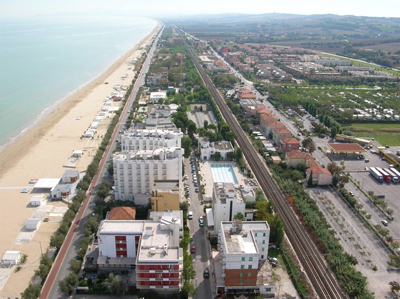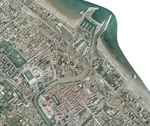You are in: Home page > Magazine Archive > Rules and norms of a urban project

Arianna Magni
Rules and norms of a urban project
A study-case in Senigallia

Aerial view, the divison in "urban areas" of the territory of Senigallia
Abstract
A seaside town, a tie infrastructure that needs to be redesigned and redeveloped, an interaction between architecture and urbanism; all these things are seen in the perspective of a necessary intervention that should be carried out by public administration: this is the context in which today the city of Senigallia should be placed today. What follows is a comprehensive research on the possibility of redeveloping the city through the use of town planning rules and an architectural project.
Article Text
Since immemorial time, urban projects have been linked to procedures and methods that want to explore every single detail of the city in order to read its morphology. Every single city that has been classified as a place of historical interest needs to be identified through some particular codes which are used in urban projects. Very often, though, the ambition of working for changes on the contemporary city to transform it into a ‘futurable city’ has to deal with insufficient methodological instruments. This, of course, does not deny the importance and the centrality of the urban project that remains fundamental in the project of redesigning the city. It points out the necessity of introducing new disciplines and descriptive instruments, as well as new rules and regulations to implement some procedures based on the exam of all those factors that influence life in a smart city nowadays.
The way followed by the administration of Senigallia, an Adriatic town, is really interesting and relevant in this perspective. It might lead the the town towards this new condition of a smart city and, at the same time, it could help an intervention to develop the city development through the use of new and efficient instruments.
The local administration is trying to achieve the goal through the introduction of new urban instruments that can be found in the regional law 22/2011 “Norme in materia di riqualificazione urbana sostenibile e assetto idrogeologico” (Norms on sustainable urban redevelopment and hydrogeological structure) submitted by Marche region.
Senigallia is a tourist town and its traffic has become too heavy (especially in summer time). For this reason, the A14 highway has become inadequate and bad traffic jams are very frequent. That’s why the administration has decided to reinforce the highway roadway corridor by building a new motorway link road at the Senigallia junction. A coplanar has been introduced as a solution to local traffic problems on the state highway 16, which is a north-south and edge-center crossing road. It has been included in an urban system that tries to link different centres in order to give continuity to urban areas.
That stretch of the state highway will surely have a lot of benefits from this infrastructural reinforcement.
In this way, because of the addition of the south coplanar the Adriatic state highway will experience a demotion. This can be a really interesting issue for the city of Senigallia, even though it might be a bit worrisome. On the one hand the state highway will see a considerable reduction of traffic congestion as it becomes a functional route of allocation. On the other hand, as an “architectural work” it could become an integral part of the areas crossed by the new road. The road will not be seen any more as a simple urban road for the movement of people and means of transport that links a town with another one, but it will be be considered as an integral part of the town/city in a context of deep urban transformation.
The administration, which is aware of this dual change, sees PORU (Programma Operativo per la Riqualificazione Urbana= Operative Plan for the Urban Redevelopment) as a suitable urban instrument for the activities of redevelopment of the state highway (SS) 16.
PORU’s aim is to improve the quality of the town and of the landscape by confining additional occupation of the soil and also by increasing eco-friendly and energetic performances of the settlements. In this way the program wants to support some of the common targets that are nowadays part of the transformation process of a “city” into a “smart city”. Its purpose is also to intervene on the city through rules of redevelopment in a simplified process, approved through fast procedures that could make things easier as, still today, a project of territorial transformation might necessarily take quite a long time. Its innovation and big potentiality come precisely from these features. PORU is ruled by public management: the local administration can start up the procedures and make a redevelopment proposal to the city or town. What about the private business? Their proposals will be taken into account on the basis of the sanction and they will have to present feasible projects that can reach a common target, starting in this way “interest demonstrations”. So PORU is the instrument chosen for the administration of Senigallia.
What emerges from all this is that there is a need of a debate with other disciplines, among these, that of architectural and urban planning.
Because of this, the public hand has submitted the fate of the state highway to the planning research contracting with the DICII (Dipartimento di Ingegneria Civile e Ingegneria Informatica= Department of Civil Engineering and Informatic Engineering) of University of Rome Tor Vergata and gives the department a task of research, oriented to the attempt of clarifying the way in which that part of the state highway SS16 will change.
For the study-case of Senigallia town, the planning research is given to an academic research group called ISity_InfraSenigalliacittà, acronym which comes from Infrastruttura-Senigallia/city -> ISity. The planning research, based on a precise regulatory framework, does not suggest a project for the town as a concluded proposal which is defined in every single detail, but it suggests a project of shapes and aims that leaves an indefinite spatial limit and an indeterminate temporal dimension. Differently from an architectural project, in which the moment of the fulfillment makes itself not negotiable anymore, the urban project is an open project that greets the use as an essential component for the attribution of meanings to its proposals. It’s a flexible project, so that it can be modified if that is asked by consultations with potential users and then it can be transformed depending on the uses it will be placed for. So the project has to reach a point but it does not have to go farther because it has to leave decision and action flexibility to public and private users.
The attitude is so that you do not have to remain chained to a solution offered just by a project but you have to reach the final solution of the problem through a behavioural code. For this reason, the research leads the administration towards pertinent planning conducts, favouring the process rather than the solution with the final result of giving also to the local designer useful guidelines through which he/she can start future actions for the constitution of the urban space. On the one hand the urban procedures dictate a mainly regulatory vision, sometimes too technical as based on rules and indices, on the other the planning research shows a really different approach: it filters information and prescriptive technocracies of the urban planner and at the same time it seems to acquire new distinctive and interpretative features of the town. It explores on new spatial levels and on an innovative relation of the building with the city, with the landscape, with the nature, questing for new and more efficient proportions through continuous state changes.
The research ISity_InfraSenigalliacittà has aligned itself on this modus operandi, declaring that its aim in replying to the petition of the administration is not to make official a ultimate architectural project but to give to the administration a reasoning, a reflection on the project, a strategy on the composition and not an official, ultimate composition, which will be useful to the administration for the arrangement of PORU.
It is able to grab potentialities which are not well known, that have to be reinvented for this part of the city and it tries to keep a distance from the traditional procedures of the planning, that dictate a mainly regulatory vision, to declare, vice versa, a necessary planning dimension that has to be put in a rebuttal with the urban norm.
The ways of change of the state highway SS16, which can be seen as a “string of pearls”, where the string is the infrastructural linear element that physically links the urban space creating at the same time interstitial spaces (Gausa, 2005), will be clarified in a scenario, where not only really concrete instruments, represented by urban devices, but also the architectural project as a communicable procedure, will be in the running.
It is a transformation that activates a continuous planning process, not necessarily deductive, even though it remains inside a realization strategy of the current transformation and redevelopment of the town/city plan. The architectural discipline relates to the urban one and vice versa, activating a dialectic process that nowadays we increasingly find in a more intense way in the constructing mechanisms of the urban project.
The approach of the administration of Senigallia – looking at several aspects and leaving, already at the starting stage of the urban project, the strong sectoralization among the involved positions, is a first strong sign, common to some other local realities, of projecting the town/city towards a “smart” developing future. On the way from a “city” to a “smart-city”, in a certain sense, that city wall which is painted around the city in the allegory of a good government, has to be culturally demolished.
Arianna Magni (Viterbo 1988), PhD in Architecture and Construction at the University of Rome "Tor Vergata", Department of Civil Engineering and Computer Engineering (DICII). She focuses her studies on themes of urban infra-structure, the transition from city to smart-city and the role of urban design. She worked from 2012 to research PRIN (2009) titled "FROM URBANIZED COUNTRYSIDE TO EXPAND-ED CITY. The norms of composition for the architecture of the territory of minor centres”. She was tutor in the workshop ReTHINK!NG. ARCHITECTURE COMPETITIONS: Temporary Housing for surfers in Tarifa, in the same department (DICII). From 2014 she is a member of the research group ISity_InfraSenigalliacittà, as a collaborator.














